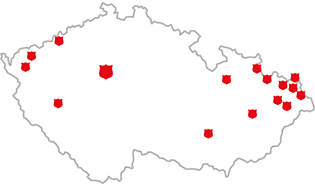Když se tak zamyslím nad hvězdou, která byla významnou součástí prvního vánočního příběhu, uvědomím si, že vědci se na hvězdy na obloze dívají úplně jinak než já. Například k měření vzdálenosti hvězd od nás na Zemi používají světelné roky. Světelný rok je vzdálenost, kterou světlo urazí za jeden pozemský rok, tedy asi 5,88 bilionu mil (nebo 9,46 bilionu kilometrů).
Slunce je naší nejbližší hvězdou a je od nás vzdáleno asi 93 milionů mil. Světlu ze Slunce tedy trvá přibližně 8 minut a 20 sekund, než k nám dorazí, což znamená, že vidíme Slunce takové, jaké bylo před více než 8 minutami. Další nám nejbližší hvězda – Alfa Centauri – je od nás vzdálena asi 4,3 světelného roku, takže když se na tuto hvězdu díváme dnes, vidíme ji tak, jaká byla před 4,3 lety. Je to, jako bychom se dívali zpět v čase.
To znamená, že mudrci, o nichž se píše v Matoušově evangeliu 2, 1-2, museli vidět hvězdu, jejíž světlo zářilo ještě dříve, než ji mohli spatřit. A přesto Bůh použil tuto hvězdu, aby je přivedl k Ježíši: „Kde je ten narozený židovský král?“ ptali se. „Spatřili jsme na Východě jeho hvězdu a přišli jsme se mu poklonit.“(Matouš 2,2 Bible21). Ježíš přišel, aby byl Světlem světa. Přišel, aby zazářil svým světlem v temnotě – v naší temnotě, v temnotě tohoto světa. V Izajáši 9,1 (ČEP) čteme, že všichni lidé jsou ve světle: V tomto překladu se píše: “ Lid, který chodí v temnotách, uvidí velké světlo; nad těmi, kdo sídlí v zemi šeré smrti, zazáří světlo.“ To bylo předpovězeno dávno předtím, než se narodil Ježíš.
Mluvíme v souvislosti s Ježíšem o světelných letech? Ne, myslím, že ne, protože Bible nám říká, že on je alfa a omega – počátek a konec. Dnes je stejně jasným světlem jako na počátku času nebo když přišel na zem, aby se usadil a „žil mezi námi“ (Jan 1,14 SNC).
Ježíš není omezen časem. Je ‚světlem světa‘ (Jan 8,12) a svítí do nejtemnějších míst našeho neklidného světa a přináší změnu. Světlo přišlo! Od tohoto Světla nás nemohou oddělit žádné světelné roky. Je zde, zná nás a my s ním nyní můžeme chodit a mluvit. Smyslem jeho příchodu bylo být s námi, ale on byl a vždycky bude s námi.
Pokud ho ještě neznáte, můžete toto Světlo světa poznat i vy. Jmenuje se Ježíš a přišel na svět, aby přinesl proměnu. Pokud hledáte změnu, hledejte Ježíše. Pokud žijete v temném místě života, hledejte toho, který je Světlem světa.
Těm, kteří již Ježíše znají, připomíná, že jsme světlem ve světě. V Matoušově evangeliu 5,14 čteme: „Jste tu proto, abyste byli světlem a přinášeli světu Boží barvy. Bůh není tajemství, které je třeba skrývat. Jdeme s ním na veřejnost, na veřejnost jako město na kopci.“ (Volně dle anglické parafráze The Message) V tomto případě je to pravda.
Kéž jste o letošních Vánocích zdrojem světla ve svém koutě světa, když přinášíte Světlo světa ostatním!
Kéž vám Bůh bohatě žehná po celé toto vánoční období!
Brian Peddle Generál
ENG:
When I consider the star that was a significant part of the first Christmas story, I’m reminded that scientists view the stars in the sky very differently than I do. For instance, they use light years to measure the distance of the stars from us on earth. A light year is the distance light travels in one earth year, so about 5.88 trillion miles (or 9.46 trillion kilometres).
The sun is our closest star and is some 93 million miles away. So, the sun’s light takes about 8 minutes and 20 seconds to reach us, meaning we see the sun as it was more than 8 minutes ago. The next closest star to us – Alpha Centauri – is some 4.3 light years away, so when we view this star today, we see it as it was 4.3 years ago. It’s as if we are looking back in time.
This means that the Magi written about in Matthew 2:1-2 would have seen a star whose light was beaming before they could even see it. And yet, God used that star to lead them to Jesus: ‘Where is the newborn king of the Jews? We saw his star as it rose, and we have come to worship him’ (Matthew 2:2 New Living Translation).
Jesus came to be the Light of the World. He came to shine his light in darkness – our darkness, the darkness of this world. We read in Isaiah 9:2 (New International Version): ‘The people walking in darkness have seen a great light; on those living in the land of deep darkness a light has dawned.’ This was prophesied long before Jesus was born.
Are we talking about light years when it comes to Jesus? No, I don’t think so, because the Bible tells us he is the alpha and omega – the beginning and the end. He is as much a bright light today as he was at the beginning of time, or when he came to the earth to take up residence and ‘move into the neighborhood’ (John 1:14 The Message).
Jesus is not constrained by time. He is the ‘light of the world’ (John 8:12) and shines light into the darkest places of our troubled world, bringing change. The Light has come! There are no light years that can separate us from this Light. He is here, he knows us, and we can walk and talk with him now. His purpose in coming was to be with us, but he has been, and always will be, with us.
If you do not know him already, you too can know this Light of the World. His name is Jesus, and he came to the world to bring about transformation. If you are seeking change, seek Jesus. If you are living in a dark place in life, seek him who is the Light of the World.
For those who already know Jesus, he reminds us that we are light in the world. In Matthew 5:14 (The Message) we read: ‘You’re here to be light, bringing out the God-colors in the world. God is not a secret to be kept. We’re going public with this, as public as a city on a hill.’
May you be a source of light in your corner of the world this Christmas, as you bring the Light of the World to others!
May God richly bless you throughout this Christmas season!
Brian Peddle
General




